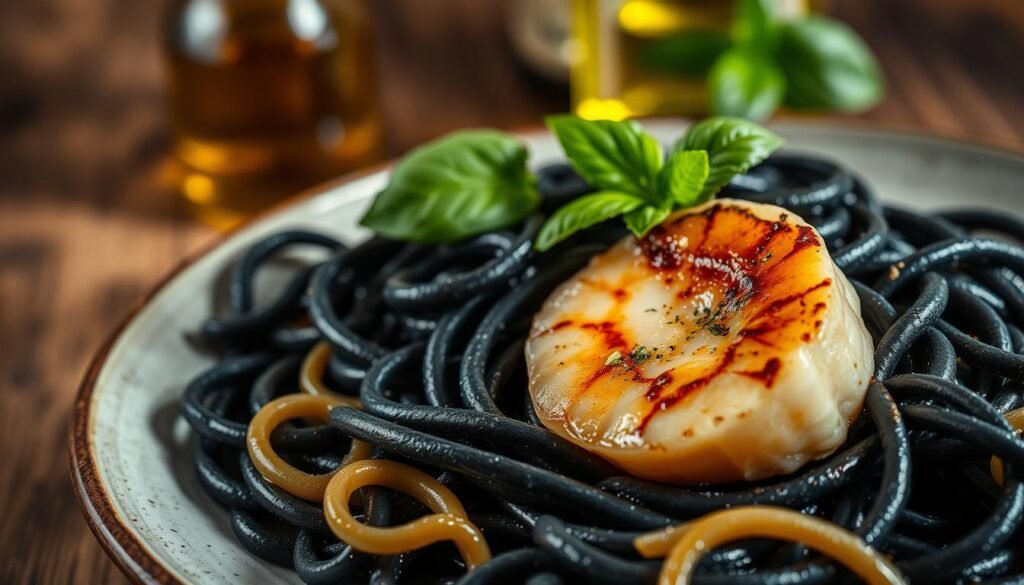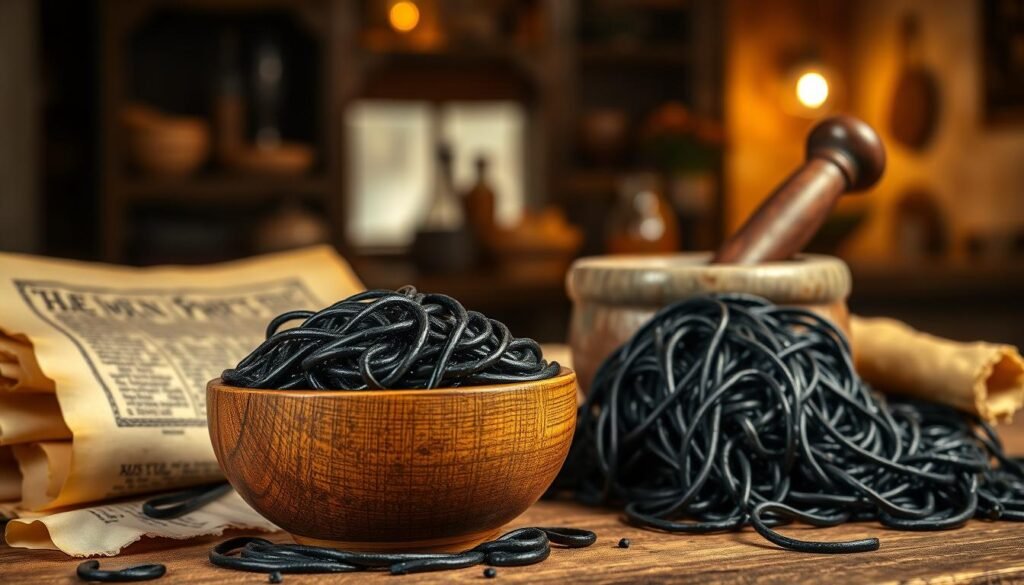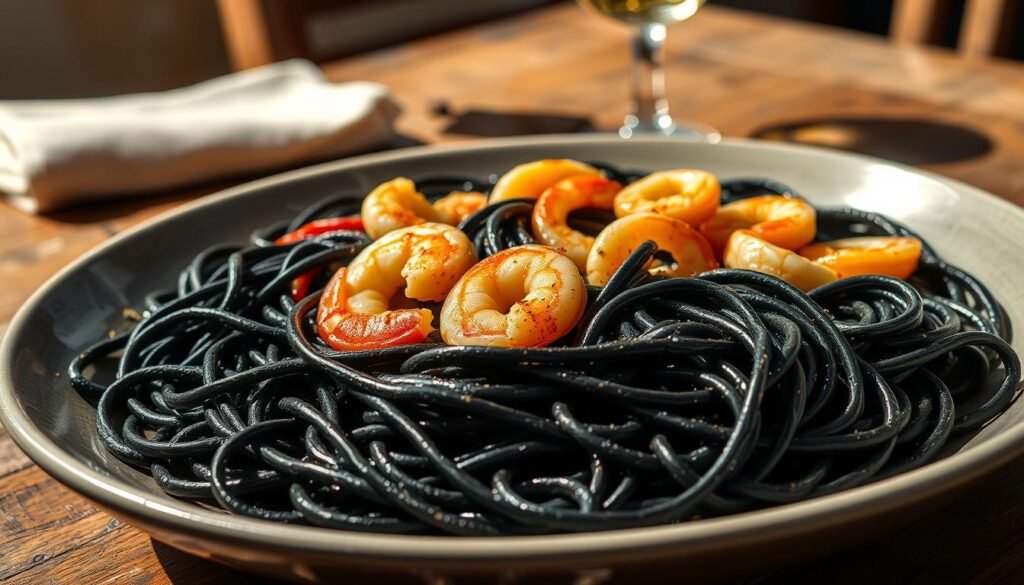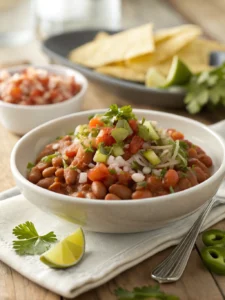Ever looked at black pasta and wondered how chefs make it look so fancy? Squid ink pasta turns simple meals into stunning, flavorful dishes. It’s not just for restaurants; you can make it at home too. This dish combines the sea’s essence with ease, perfect for seafood fans or adventurous cooks.How to Make Squid Ink Pasta: A Step-by-Step Recipe
Learn to mix squid ink’s boldness with fresh ingredients like shrimp or mussels. This guide covers every step, from picking the right pasta to choosing wine. You don’t need special tools; your kitchen has everything. Soon, you’ll turn a simple pasta night into a memorable seafood feast.
Key Takeaways
- Learn to prepare squid ink pasta using common kitchen tools.
- Understand how squid ink adds umami depth without overpowering.
- Get tips for balancing briny flavors with herbs like garlic and parsley.
- Find out which wines complement ink pasta’s unique taste.
- Discover vegetarian swaps to enjoy this dish without seafood.
What Is Squid Ink Pasta and Why You Should Try It
Squid ink pasta, or ink pasta, is made by adding squid ink to pasta dough or sauce. This gives it a striking black color. It’s not scary, but rather a bold culinary adventure.
The squid ink spaghetti you might find in restaurants or at home has a subtle briny taste. It also has a hint of the sea and a touch of sweetness.
“The ink adds depth without being overpowering,” says Chef Maria Costa, a seafood specialist. “It’s all about enhancing flavors, not overwhelming them.”
Some people think squid ink pasta tastes too fishy, but it’s actually more complex. Its umami-rich flavor goes well with seafood like shrimp or clams. This creates a perfect balance on your tongue.
The texture is familiar, whether it’s creamy sauces or al dente noodles. This lets you focus on getting creative with your dishes.
- Eye-catching presentation: The deep black color makes any dish a visual standout.
- Unique taste experience: Subtle ocean notes without fishiness.
- Versatile base: Use it in everything from classic squid ink pasta recipe dishes to creative adaptations.

Trying this ingredient can open up a world of flavors. Even if you’re new to seafood, squid ink spaghetti is a great place to start. Its bold look and mild taste make it perfect for trying new things or impressing guests.
The Fascinating History Behind Squid Ink Pasta
Discover how squid ink pasta went from coastal traditions to today’s tables. Its story is one of resourcefulness and creativity.
The Mediterranean Origins of Ink Pasta
In places like Spain, Italy, and Greece, fishing communities started using squid ink. They made sure to use every part of the squid. This led to dishes like Spain’s arroz negro and Italy’s pasta al nero di seppia.
These dishes were first made by fishermen. They used fresh seafood to create hearty meals.

How Squid Ink Became a Culinary Delicacy
Chefs like Spain’s David Muñoz brought squid ink into the spotlight. They showed its rich flavor, not just its color. Now, it’s a key ingredient in fancy dishes.
Today, squid ink is harvested carefully and sold as a luxury item. It’s found in gourmet stores.
Modern Popularity of Squid Ink Dishes
Social media has made squid ink dishes popular. Posts about #blackpasta are everywhere. This has made it trendy.
Now, you can find squid ink pasta in stores like Whole Foods. Chefs are using it in all sorts of dishes. It’s a symbol of both tradition and new ideas in cooking.
Essential Ingredients for the Perfect Squid Ink Pasta Recipe
To make a great squid ink pasta recipe, you need the best ingredients. Here’s how to pick each one for the best taste and authenticity.
Choosing the Right Squid Ink
Squid ink is available in packets, jars, or fresh from fishmongers. Choose products with few additives. Look for dark, rich color in jars or packets. Avoid faded colors, which mean the product is old.
Buy from trusted places like World Spice Merchants or Marinara Seafood Market. Keep unopened ink in a cool, dark spot for up to 6 months. Once opened, refrigerate and use within two weeks. If you can’t find squid ink, cuttlefish ink is a good substitute, but it tastes milder.
Always check the expiration date and avoid cans with dents.
Fresh Seafood Options for Your Dish
Choose seafood like shrimp, clams, or mussels to go with squid ink. For the best squid ink seafood pasta recipe, pick firm, odorless seafood. In spring, go for clams, and in winter, mussels are great.
For sustainable options, check Seafood Watch. If you have allergies, try roasted veggies or chickpeas. Look for clear eyes, no slimy feel, and a briny smell in your seafood.
Complementary Herbs and Spices
Garlic, parsley, and red pepper flakes are classic Mediterranean choices that complement squid ink’s flavor. Add lemon zest to balance the taste. For a unique twist, try smoked paprika or saffron.
Use fresh herbs for homemade dishes and dried for store-bought. Be careful not to over-salt, as squid ink is naturally salty.
Selecting the Ideal Pasta Type
Linguine or spaghetti work best with squid ink’s sauce because they cling well. When buying pasta, make sure it’s evenly coated with ink. Avoid clumps.
For homemade pasta, use 0.5 oz squid ink powder per 1 cup flour. For gluten-free, try Buona Speranza chickpea pasta. Shapes like tagliatelle soak up sauce better than tubes.
Kitchen Equipment You’ll Need
Mastering the squid ink spaghetti starts with the right tools. A large pot with a lid boils pasta evenly. A colander with large holes drains quickly without trapping water. A wide sauté pan ensures sauces coat every strand of ink pasta.
- Non-reactive cookware: Stainless steel or enameled cast iron prevents chemical reactions with acidic ingredients.
- Pasta tongs: Tongs flip seafood and pasta without breakingage. A spider strainer lifts shrimp or calamari from hot oil.
Measuring spoons are critical—squid ink’s bold flavor needs precise measurement. For homemade pasta, a pasta machine and cutter shape dough easily. A drying rack lets strands air-dry before cooking.
White plates or bowls showcase the pasta’s deep black hue. Clean tools immediately after cooking—ink stains linger on surfaces. Use separate cutting boards to keep seafood safe to eat.
Preparation Steps for Your Squid Ink Seafood Pasta
Mastering the prep ensures your squid ink seafood pasta shines. Follow these organized steps for flawless results.
Preparing the Squid Ink
Handle squid ink carefully to avoid stains and achieve perfect color:
- Packet/jar ink: Mix 1 tsp powdered or liquid ink with ¼ cup water before adding to dough/sauce
- Fresh squid ink: Squeeze from cleaned squid, strain through a sieve to remove debris
- Protect surfaces with silicone mats and wear gloves to prevent staining
Measure precisely: Use 1 tbsp ink per 1 cup pasta dough or ½ tsp per sauce cup for balanced flavor. If clumps form, strain again before use.
Cleaning and Preparing Your Seafood
| Seafood | Steps |
|---|---|
| Shrimp | Peel, devein with a paring knife, pat dry |
| Squid | Remove translucent skin, cut open, scrape out quill, rinse thoroughly |
| Mussels | Scrub shells, twist to remove beard, discard cracked shells |
| Clams | Check for closed shells; soak in salted water 10-15 mins before use |
Thaw frozen seafood in the fridge overnight. Keep cleaned items chilled until cooking to maintain texture and safety.
Creating the Perfect Sauce Base
- Sauté minced shallots and garlic in olive oil until translucent
- Add a splash of dry white wine, simmer until reduced by half
- Whisk in chicken broth, then incorporate squid ink gradually while stirring
- Balancing acidity with a squeeze of lemon juice or richness with a knob of butter
Make-ahead tip: Prep aromatics and sauce base up to 24 hours ahead; refrigerate separately.
Cooking Your Squid Ink Pasta to Perfection
Mastering the squid ink pasta recipe needs careful timing and technique. Start by boiling water with 1-2 tablespoons of salt per quart. This helps the pasta soak up flavor. Add your squid ink spaghetti and stir gently to avoid clumps. Ink pasta cooks faster, usually in 8-10 minutes. Check the package but remember, it cooks quicker.
Test a strand at the minimum cooking time. It should feel slightly firm in the middle (al dente).
- Bring water to a rolling boil. Add pasta, stir, and cook 1-2 minutes less than regular pasta.
- Reserve 1 cup pasta water before draining. This starchy liquid helps sauce cling to noodles.
- Drain pasta but do not rinse—it removes starch needed for sauce adhesion.
- Transfer pasta directly to sauce pan over medium heat. Toss 1-2 minutes, adding reserved water as needed for creaminess.
| Step | Action |
|---|---|
| 1 | Boil salted water (1-2 tbsp per quart) |
| 2 | Cook pasta 1-2 mins less than standard times |
| 3 | Reserve 1 cup pasta water before draining |
| 4 | Combine pasta and sauce, adding water for consistency |
Avoid rinsing pasta—this removes essential starch. If sauce is too thick, add reserved water 1/4 cup at a time. The ink’s deep black hue may stain pans and surfaces; non-stick cookware works best. Serve immediately to preserve the ink pasta’s vibrant color and texture.
Test doneness by biting into a strand—ideal pasta should offer slight resistance. Overcooked pasta becomes mushy; undercooked remains hard. Adjust cooking time by 30-second increments for personal preference.
Delicious Serving Suggestions for Squid Ink Spaghetti
Pair your squid ink pasta recipe with flavors and presentation that enhance its bold taste. Start with wine choices that match its briny depth. Vermentino or Albariño whites cut through the dish’s richness, while a light Pinot Noir offers red drinkers a subtle contrast. Opt for Mediterranean-inspired pairings like crisp Sauvignon Blanc or sparkling water with lemon for a non-alcoholic option.
Wine Pairing Recommendations
- Crisp squid ink seafood pasta recipe pairs best with acidic whites like Vermentino, which balances umami notes.
- For reds, choose light Pinot Noir to avoid overpowering the pasta’s delicate flavors.
- Sparkling water with lemon refreshes the palate between bites.
Side Dishes That Complement Ink Pasta
Keep sides light to let the pasta shine. Try a squid ink spaghetti meal with:
- Bright green salads dressed with citrus vinaigrettes.
- Toasted bread for dipping into sauce.
- Roasted fennel or asparagus to mirror Mediterranean roots.
Small portions work best—aim for sides that complement without overwhelming.
Presentation Tips for Impressive Serving
Use white plates to highlight the pasta’s jet-black hue. Garnish with lemon zest or chili flakes for color pop. Arrange seafood like shrimp or clams on top. Serve family-style or individually, keeping the dish warm to preserve seafood freshness.
Exciting Variations of the Classic Squid Ink Pasta Recipe
Try new things with squid ink pasta. You can make it into creamy risotto or add a spicy kick. These changes show how versatile squid ink is, keeping its special taste.
Squid Ink Risotto Alternative
Turn your squid ink pasta into a creamy risotto. Use Arborio rice for its creamy texture. Stir constantly while adding broth slowly.
Finish with mantecatura—butter and Parmigiano-Reggiano. This makes it silky. Add shrimp or mussels and a squeeze of lemon for a bright touch.
Creamy Squid Ink Pasta Version
Make a rich squid ink pasta with cream. Start by sautéing garlic and onion. Then, deglaze with white wine and add cream and lemon.
Slowly add cream to avoid curdling. Try it with clams for a Venetian taste or herbs for a Provencal flavor. Don’t overdo it with seasoning.
Spicy Squid Ink Seafood Pasta Options
Add spice without hiding the ink’s flavor. Start with red pepper flakes. Then, add Calabrian chilies during cooking.
For more heat, sprinkle black pepper at the end. Try Thai or Mexican flavors with lemongrass and chili or smoked paprika. Adjust the seasoning as you go.
Vegetarian Adaptations
Make squid ink pasta for vegetarians by using mushrooms or eggplant. Add soy sauce or miso for depth. Look for vegan squid ink options.
Use nutritional yeast and cashew cream for a dairy-free sauce. Serve with spinach or black beans for extra texture.
Nutritional Benefits of Squid Ink Pasta
Trying a squid ink pasta recipe is more than just a taste adventure. It’s a chance to get some special nutrients from the squid ink. This ink is packed with melanin, antioxidants, and anti-inflammatory compounds. These help keep your body healthy by fighting inflammation and oxidative stress.
The squid ink also brings iron, copper, and zinc to your squid pasta. These minerals are key for energy, a strong immune system, and fixing cells. Compared to regular pasta, ink pasta has the same calories but with more nutrients. The ink’s amino acids also offer protein benefits without extra calories.
- Iron & copper for energy and blood health
- Zinc to boost immunity
- Omega-3s from seafood pairings like shrimp or clams
Adding fresh seafood to your dish makes it even healthier. Scallops or calamari add lean protein and omega-3s. Traditional Mediterranean diets have always praised squid ink for its health benefits. Modern research is starting to uncover its antimicrobial properties.
Remember, while the ink is gluten-free, always check pasta brands for gluten-free labels. If you have shellfish allergies, talk to a doctor before trying squid-based dishes. The ink does have sodium, so pair it with low-sodium sides.
Ink pasta isn’t a superfood, but it’s a great choice for those who love to try new things. Its unique nutrients and flavors make it a standout. Enjoy it as part of a balanced diet for both taste and nutrition.
Troubleshooting Tips for Common Squid Pasta Challenges
If squid ink stains your hands or surfaces, act quickly. Use lemon juice or baking soda paste to clean your hands. For cutting boards, soak them in warm soapy water with hydrogen peroxide. Stainless steel sinks can also help remove stains.
To fix a too-thin sauce, simmer it uncovered to reduce the liquid. If it’s too thick, add reserved pasta water a quarter cup at a time. Always taste the sauce before mixing it with squid ink spaghetti to avoid it becoming too thick.
Did you overcook the pasta? Use it in frittatas or salads. If it’s undercooked, briefly reboil it in salted water. Add a pinch of olive oil to prevent squid ink pasta from sticking while cooking.
| Problem | Solution |
|---|---|
| Rubbery seafood | Parboil seafood briefly before adding to sauce |
| Overpowering saltiness | Blend in a raw potato slice to absorb excess salt |
| Faded ink color | Stir in a drop of squid ink powder mid-cooking |
If seafood textures vary, cook delicate scallops separately from shrimp. Let tougher calamari tentacles simmer longer. For overly fishy flavors, add a grated carrot or fennel to mellow the taste.
Clumping pasta? Toss cooked squid ink pasta with a light oil mixture immediately. Store leftovers in airtight containers for up to 2 days. Reheat with a splash of pasta water to restore texture.
Mistakes happen—imperfect squid ink pasta recipe batches can still shine in creative dishes. Experiment with adding pesto to under-seasoned pasta or mixing leftovers into omelets. Mastery comes with practice, so don’t fear imperfections!
Conclusion: Mastering the Art of Homemade Squid Ink Pasta
Now you know the squid ink pasta recipe and its history. It’s time to make this Mediterranean tradition in your kitchen. The squid ink spaghetti’s black color might seem bold, but with the right steps, you’ll succeed.
Start with the basic recipe, then try different flavors. You can add creamy sauces or spicy touches. Each change lets you make the dish your own.
This recipe is more than cooking—it’s a chance to be creative. Whether it’s for a simple dinner or a big event, its look will wow your guests. The sauce’s richness and the pasta’s texture make it a hit, perfect for sharing your cooking story.
Don’t worry about stains; simple steps keep things clean. And, the right seasoning keeps the ink’s flavor balanced.
As you get better, try new things like vegetarian options or local twists. Each try makes you more confident, turning you into a squid ink pasta expert. Share your dishes online with hashtags to inspire others. Remember, every great chef starts with one recipe. Your journey begins here, mixing tradition and innovation in every bite.
FAQ
What is squid ink pasta made from?
Squid ink pasta is made from regular pasta dough with squid ink added. This gives it a black color and a hint of brininess. It can also be regular pasta with a squid ink sauce.
Does squid ink pasta have a strong fishy taste?
No, squid ink pasta doesn’t have a strong fishy taste. It has a subtle umami flavor with a hint of brininess. This flavor complements seafood dishes well and is easy for those new to seafood to enjoy.
How do I cook squid ink spaghetti perfectly?
Start by salting your boiling water. Add the pasta and cook as the package says, usually less than regular pasta. Check if it’s al dente. Then, save some pasta water before draining to help with sauce.
What types of seafood pair well with squid ink pasta?
Squid ink pasta goes great with seafood like shrimp, scallops, mussels, and calamari. These add to the dish’s flavors, making for a great seafood experience.
Can I make a vegetarian version of squid ink pasta?
Yes, you can make a vegetarian version. Use vegetable-based sauces instead of seafood. Try roasted vegetables or savory mushrooms for a unique twist.
How can I store leftover squid ink seafood pasta?
Keep leftovers in an airtight container in the fridge for up to 2 days. Reheat gently on the stovetop with a bit of water or broth. This helps the sauce stay right and the pasta from drying out.
Does squid ink pasta offer any nutritional benefits?
Yes, squid ink is full of antioxidants and minerals like iron, copper, and zinc. With seafood, it’s a nutritious meal, offering high-quality protein and omega-3 fatty acids.
Why is squid ink considered a culinary delicacy?
Squid ink is loved for its unique color, flavor, and the special touch it adds to dishes. Its rich history in Mediterranean cuisine and its ability to elevate pasta make it a favorite among chefs and food lovers.



